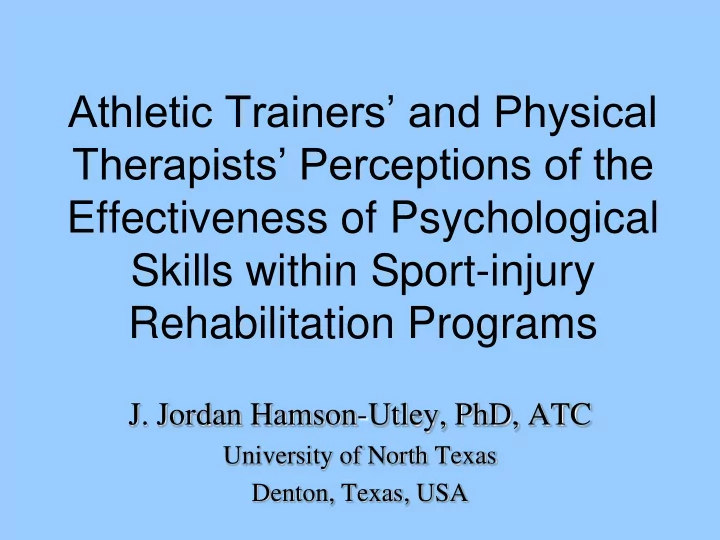

Athletic Trainers’ and Physical Therapists’ Perceptions of the Effectiveness of Psychological Skills within Sport-injury Rehabilitation Programs J. Jordan Hamson-Utley, PhD, ATC University of North Texas Denton, Texas, USA
Sport-injury Rehabilitation • Incidence of sport-injury – 1 in 4 college athletes (4 weeks+) (Prentice, 2006) – 1 in 6 high school athletes (4 weeks+) • Current Rehabilitation Trend: “physical injury” • Psychological Aspects of Injury – Lack of adherence and prolonged recovery rate • Decreased motivation to attend therapy and work ethic • Anxiety about pain or readiness to return to sport • Decreased self-confidence /self-worth
Proposed Health Benefits of Mental Imagery Use with Injured Athletes • Anxiety reduction (Green, 1999) • Relaxation/decrease muscle tension (Benson, 1997) • Pain control (Hamson, 2007) • Promote healing within the body (Ievleva & Orlick, 1991) • Increase self-confidence (Garza & Feltz, 1998) • Promote adherence (Brewer, 1998) • Decrease recovery time (Ievleva & Orlick, 1991; 1999)
Reasons for Lack of Implementation • “Physical Injury” • Educational/Clinical Exposure to the Technique – Accredited Program Requirements (NATA/APTA) • 2001-present Psychological Aspects of Injury (competency) • Physical Therapists are not required to have training – Lack of continuing education opportunities • Lack of interest in gaining Continuing Education – Potentially identifying negative attitudes
Research Questions 1. Do Athletic Trainers and Physical Therapists differ in their attitudes toward the effectiveness of mental imagery used to rehab injured athletes? 2. Is there an effect of accredited education programs for Athletic Trainers? 3. If therapists are interested in gaining formal continuing education on mental imagery, do they have more positive attitudes on its effectiveness? 4. If a therapist gains formal training, are their attitudes toward mental imagery use with athletes more positive?
Procedures and Participants • Survey distribution (APTA & NATA databases) – N = 665; 33% overall response rate – Physical Therapists: 1000 mailed surveys – Athletic Trainers: 1000 emailed surveys • Response Rate & Participant Demographics – Physical Therapists (n = 356) • age = 38.58 7.51 • years in profession = 13.18 6.17 – Athletic Trainers (n = 309) • age = 34.01 8.32 • years in profession = 10.67 7.34
Attitudes About Imagery (AAI): Sample Questions • Mental Imagery (8) – Mental imagery is an effective way to increase focus on specific rehab exercises. • Positive Self-talk (3) – The use of positive self-talk is an effective way to decrease pain during rehab exercises. • Controlling Pain (2) – Controlling the level of pain associated with rehab exercises will help speed up the recovery process. • Goal Setting (2) – Setting appropriate rehab goals will help improve the athlete’s adherence rate.
Survey Results: Question 1 Do Athletic Trainers and Physical Therapists differ in their attitudes toward the effectiveness of mental imagery used to rehab injured athletes? ATC PT ANOVA M(SD) M(SD) F(p) ES Mental Imagery 5.39(.99) 5.29(.96) 1.7(.19) .10 Positive Self-talk 6.09(.72) 5.88(.91) 10.66(.001) .29* Controlling Pain 6.35(.77) 6.06(1.03) 17.0(.000) .38* Goal Setting 6.43(.78) 5.94(1.0) 49.30(.000) .63* 4 Subscales on the AAI. 7-point Likert scale. * = significant
Survey Results: Question 2 Is there an effect of accredited education programs for Athletic Trainers? Yes No ANOVA M (SD) M(SD) F(p) ES n = 210 n = 145 Mental Imagery 5.34(1.06) 5.33(0.95) .002(.962) .01 Positive Self-talk 6.02(0.87) 6.04(0.70) .045(.883) .03 Controlling Pain 6.32(0.90) 6.21(0.90) 1.39(.239) .12 Goal Setting 6.39(0.91) 6.32(0.81) .573(.450) .09 4 Subscales of the AAI. 7-point Likert scale. * = significant
Survey Results: Question 3 If therapists are interested in gaining continuing education on mental imagery, do they have more positive attitudes on its effectiveness? Yes No ANOVA M(SD) M(SD) F(p) ES n = 415 n = 250 Mental Imagery 5.56(0.89) 4.99(1.00) 59.67(.000) .64* Positive Self-talk 6.08(0.77) 5.80(0.90) 18.59(.000) .36* Controlling Pain 6.29(0.88) 6.04(1.00) 11.15(.001) .28* Goal Setting 6.29(0.85) 5.96(1.02) 20.04(.000) .39* 4 Subscales of the AAI. 7-point Likert scale. * = significant
Survey Results: Question 4 After a therapist gains formal training, are their attitudes toward mental imagery use within rehabilitation program of athletes more positive? Yes No ANOVA M(SD) M(SD) F(p) ES n = 115 n = 550 Mental Imagery 5.66(0.86) 5.27(0.98) 15.32(0.00) .45* Positive Self-talk 6.19(0.62) 5.93(0.86) 9.68(.002) .42* Controlling Pain 6.29(0.89) 6.18(0.94) 1.19(.227) .12 Goal Setting 6.50(0.70) 6.10(0.96) 16.97(.000) .57* 4 Subscales of the AAI. 7-point Likert Scale. * = significant
Discussion & Implications • Held attitudes are different effect use, therapist selection – Athletic Trainers and Physical Therapists are similar on their attitudes toward the effectiveness of mental imagery (6 of 8 AAI items; overall a positive attitude) • Effect of Educational Competencies (Athletic Trainers) – Disconnect between the education and implementation • Clinical Experience with mental imagery? – Potentially a 5-year follow-up post certification – Should APTA add an educational competency? • Interest in gaining formal training – Would you enroll in a workshop? (N + 415; 62% overall) –
Discussion & Implications (cont.) • Effects of having formal training on Mental Imagery – Attitudes are significantly more positive on 3 of 4 AAI subscales (excluding pain control) • Yes(6.29), No (6.18), p = .277, ES(.12) • N = 115; 17% reported having formal training • Interest in gaining formal training on Mental Imagery – Would you enroll in a workshop? (N = 415; 62% overall) – Attitudes significantly more positive on all subscales of the AAI • Positive effect on implementation – Lack of continuing education at NATA/APTA conventions
Questions/Suggestions?
Recommend
More recommend